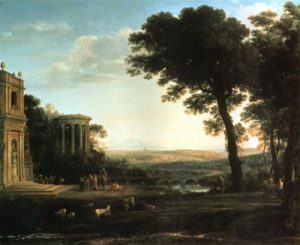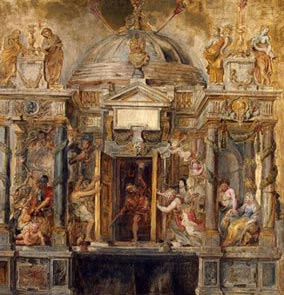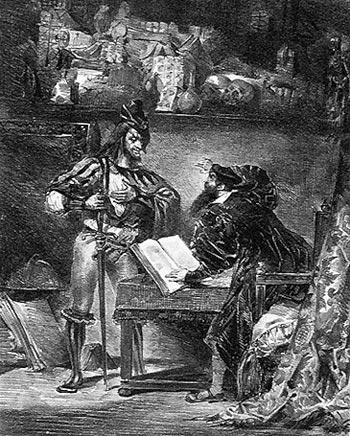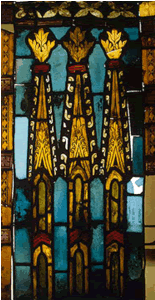Romanticism
 Romanticism (French romantisme from the Latin. Roman romanum from Roma – Rome) is one of two, along with Classicism, the fundamental tendencies of artistic thinking. However, historically, this word has been called a wide range of various phenomena. At the end of the 18th century, everything extraordinary, fantastic, what happens “like in novels” was called romantic or “romance”. Romantic, sublime poetry was then considered the only worthy type of art. But there was another interpretation of the term: romantic – this is the art of the Romance peoples, mainly medieval, which was opposed to the classical, ancient. The French word “roman” originally meant literary works written not in classical Latin, but in vulgar, popular dialects. Therefore, under the romantic art, they first understood the art of the Middle Ages, including the Renaissance, which was not distinguished in a special era. The modern name “novel” is a drama for reading, more often a love story, the composition and style of which deviate from the classical rules. From here comes the word romance (French romance, art. French romanz).
Romanticism (French romantisme from the Latin. Roman romanum from Roma – Rome) is one of two, along with Classicism, the fundamental tendencies of artistic thinking. However, historically, this word has been called a wide range of various phenomena. At the end of the 18th century, everything extraordinary, fantastic, what happens “like in novels” was called romantic or “romance”. Romantic, sublime poetry was then considered the only worthy type of art. But there was another interpretation of the term: romantic – this is the art of the Romance peoples, mainly medieval, which was opposed to the classical, ancient. The French word “roman” originally meant literary works written not in classical Latin, but in vulgar, popular dialects. Therefore, under the romantic art, they first understood the art of the Middle Ages, including the Renaissance, which was not distinguished in a special era. The modern name “novel” is a drama for reading, more often a love story, the composition and style of which deviate from the classical rules. From here comes the word romance (French romance, art. French romanz).
The origin of the words “romance”, “romance” is associated with the awareness of romance as a property of the human soul. The concept of romance is wider than romanticism. Romantic feelings, dreams, a romantic act is always something sublime, noble, disinterested, not connected with any calculation and therefore enthusiastic, divorced from reality and aspiring to some kind of foggy, unrealizable ideal.
Thanks to the all-pervading romantic beginning of artistic creativity, Romanticism is not only opposed to Classicism, but also associated with it. Many artists were genuine romantics of Classicism: A. Mantegna, N. Poussin, C. Lorrain, J.-B. Piranesi, P. Gonzaga and many others. Romance was Rembrandt and the apologist of academic classicism J.-D. Ingr. Therefore, there is even such a term “romantic classicism”. Romanticism and Classicism “walked together” all the time, and only in France at the beginning of the 19th century did their paths diverge. Therefore, in a narrower, concrete historical sense, Romanticism is often understood as a certain artistic direction of the end of the XVIII – beginning of the XIX centuries, the adherents of which consciously, programmatically opposed their creativity to the Classicism of the XVII and second half of the XVIII centuries.
Many believe that Romanticism as an artistic movement took shape for the first time in English painting as early as the middle of the 18th century, partly influenced by the aesthetics of Classicism and the landscape style of English gardens. In the 1790s, the innovation of the painting technique by T. Gainsborough marked the beginning of the “pittoresk” or “picchuresque” flow (English picturesque – pictorial). This term meant the painting of the novelists C. Lorrain, N. Poussin, S. Rose, and then their landscape painters, such as W. Turner. The English landscape, like the English landscape style in park art, is typical Romanticism, reflecting the desire for a natural, elemental sense of beauty in nature. Following England, Romanticism became widespread in Germany, but there he immediately acquired a more mystical coloring.
The ideological essence of Romanticism consists in a direct appeal to the human soul, bypassing the historical styles and canons of academic Classicism. Ideas of romanticism naturally arise on the basis of dissatisfaction with reality, the crisis of the ideals of Classicism and rationalistic thinking, the desire to go into the world of ideal ideas, utopian dreams of the perfection of the world. As in no other direction of art, romance artists are convinced that their direction is the only true way.
The main idea of romantic artistic thinking is the pursuit of the irrational, the unknown. Therefore, the era of Romanticism of the end of the XVIII – beginning of the XIX centuries is the time of the most effective manifestation of romantic artistic thinking, only partly caused by the crisis of academic Classicism, and, in a deeper sense, the result of periodic “swing of the pendulum” from one pole to another, from materialism to idealism , from rational thinking to a mystical sense of reality. In this sense, all medieval art: early Christian, Byzantine, Romanesque, Gothic – typical Romanticism!



